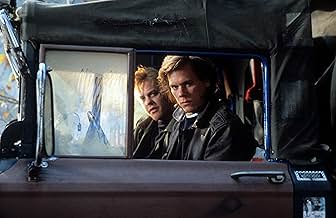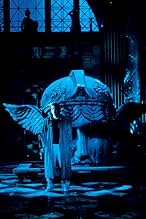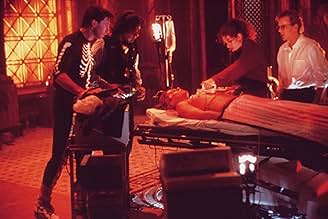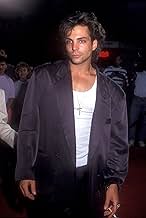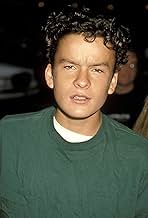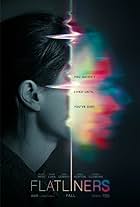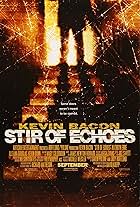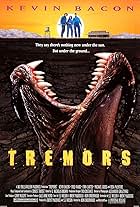Five medical students experiment with "near death" experiences, until the dark consequences of past tragedies begin to jeopardize their lives.Five medical students experiment with "near death" experiences, until the dark consequences of past tragedies begin to jeopardize their lives.Five medical students experiment with "near death" experiences, until the dark consequences of past tragedies begin to jeopardize their lives.
- Nominated for 1 Oscar
- 3 nominations total
John Duda
- Young Labraccio
- (as John Joseph Duda)
- Director
- Writer
- All cast & crew
- Production, box office & more at IMDbPro
Storyline
Did you know
- TriviaJulia Roberts (Dr. Rachel Mannus) and Kiefer Sutherland (Nelson Wright) started dating during filming. They ended up engaged, but Roberts ultimately broke it off. She later married Lyle Lovett.
- GoofsWhile a defibrillator is of no use if a patient has truly flatlined, a patient in a "fine v-fib" rhythm can appear to have flatlined but still be revived with the paddles. Therefore, when in doubt, the Advanced Cardiac Life Support guidelines call for administering the shock, though it's not the treatment of choice.
- Quotes
[first lines]
Nelson Wright: Today is a good day to die.
- SoundtracksPARTY TOWN
Written and Performed by David A. Stewart (as Dave Stewart)
Courtesy of BMG Records (UK) Ltd.
Featured review
Countless TV displays and the memorable appearances from 4 of today's mega-stars(plus Hope Davis's screen debut) keep Flatliners still in prudence. The plot is about a non-academic research of five medicine undergrads pursuing one's crazy idea on discovering the secret of death, and learn what's after death, then come back to life again. Yet the storyline hasn't been designed as fascinating as the idea of the plot.
There are popular stereotypes to develop a regular teen-slasher script in Flatliners. There is Nelson who creates the idea of decoding death, pretty but introverted Rachel, David who cuts the Gordian knot on luckily not to be dismissed from the school, ladies' man Joe and finally the smart guy Randy("I did not come to medical school to murder my class mates no matter how deranged they might be"). They join hands altogether in an experiment where Nelson's heart will be stopped and rerythmed. Then they decide to continue this experiment in strict confidence at night times in the campus. Not long after Nelson's experience everyone starts a race over having the wildest and the longest death experience, risking their lives one by one. Yet, soon they realize their daily life becomes affected from those experiences they had. The visits to the afterlife brings back their delinquent feelings from their childhood memories. Depolarizing their deep subconscious watchfulness, they begin having somatic delusions and visual hallucinations.
When the point comes where the explanation of subconscious, director Joel Schumacher skips that every humankind has a subconscious personality which they are not aware of. This inner personality keeps one from altering into identity loss. If you lose or if you depolarize this subconscious personality you certainly lose your identity instead of refreshing childhood memories. I wanted to add this as a movie mistake, which already has been mentioned via movie critics in the earlier 90s'. Obviously here in this movie Schumacher made the actors have it least affected. Then why do they hesitate continuing on the experiment after learning their lesson, as if death is designed indiscoverable by God? David had been introduced as an Atheist, now he turned out to believe in God when he recalled a flashback from his childhood. After witnessing this 180 degreed change in David, it's clear to see that Schumacher's film was so conservative and lily-livered; that's ultimately why it's never classified as a work of science fiction. Alas! It had a good potential. It even tried to tell the unconscious maturation from having a death experience, beginning to believe that death is so simply natural and it's only a part of a human's life.
More than what's in the movie, it was also memorable to recall what's with the movie. Jan de Bont as the cinematographer, who had worked almost every time with Schumacher, creates an dreamy atmosphere like it's being an Gothic horror movie. The blue color schemes all over the walls reflecting into the actors' faces deliver first class of lighting, that suits perfectly with the film. The close-up shots of the gargoyle statues in the campus buildings, Catholic frescoes in the walls, stop-motion cameras, and the dynamic camera speeds were all belong to Bont's skills.
Flatliners became a cult movie in time with its sociological pen-portrait of the X-generation juvenile especially via its futuristic editing style with storyboard connection sequences like being part of a video music clip so much aesthetically. Those were the times where fast-paced and multi-sequenced video music clips were on rise. This style was very rare to come across in those years after its pioneer Tony Scott's "The Hunger(1983)".
There are popular stereotypes to develop a regular teen-slasher script in Flatliners. There is Nelson who creates the idea of decoding death, pretty but introverted Rachel, David who cuts the Gordian knot on luckily not to be dismissed from the school, ladies' man Joe and finally the smart guy Randy("I did not come to medical school to murder my class mates no matter how deranged they might be"). They join hands altogether in an experiment where Nelson's heart will be stopped and rerythmed. Then they decide to continue this experiment in strict confidence at night times in the campus. Not long after Nelson's experience everyone starts a race over having the wildest and the longest death experience, risking their lives one by one. Yet, soon they realize their daily life becomes affected from those experiences they had. The visits to the afterlife brings back their delinquent feelings from their childhood memories. Depolarizing their deep subconscious watchfulness, they begin having somatic delusions and visual hallucinations.
When the point comes where the explanation of subconscious, director Joel Schumacher skips that every humankind has a subconscious personality which they are not aware of. This inner personality keeps one from altering into identity loss. If you lose or if you depolarize this subconscious personality you certainly lose your identity instead of refreshing childhood memories. I wanted to add this as a movie mistake, which already has been mentioned via movie critics in the earlier 90s'. Obviously here in this movie Schumacher made the actors have it least affected. Then why do they hesitate continuing on the experiment after learning their lesson, as if death is designed indiscoverable by God? David had been introduced as an Atheist, now he turned out to believe in God when he recalled a flashback from his childhood. After witnessing this 180 degreed change in David, it's clear to see that Schumacher's film was so conservative and lily-livered; that's ultimately why it's never classified as a work of science fiction. Alas! It had a good potential. It even tried to tell the unconscious maturation from having a death experience, beginning to believe that death is so simply natural and it's only a part of a human's life.
More than what's in the movie, it was also memorable to recall what's with the movie. Jan de Bont as the cinematographer, who had worked almost every time with Schumacher, creates an dreamy atmosphere like it's being an Gothic horror movie. The blue color schemes all over the walls reflecting into the actors' faces deliver first class of lighting, that suits perfectly with the film. The close-up shots of the gargoyle statues in the campus buildings, Catholic frescoes in the walls, stop-motion cameras, and the dynamic camera speeds were all belong to Bont's skills.
Flatliners became a cult movie in time with its sociological pen-portrait of the X-generation juvenile especially via its futuristic editing style with storyboard connection sequences like being part of a video music clip so much aesthetically. Those were the times where fast-paced and multi-sequenced video music clips were on rise. This style was very rare to come across in those years after its pioneer Tony Scott's "The Hunger(1983)".
- CihanVercan
- Oct 11, 2009
- Permalink
Details
- Release date
- Country of origin
- Language
- Also known as
- Línea mortal
- Filming locations
- Museum of Science & Industry - 57th & Lake Shore Drive, Jackson Park, Hyde Park, Chicago, Illinois, USA(exteriors: Tait Building)
- Production companies
- See more company credits at IMDbPro
Box office
- Budget
- $26,000,000 (estimated)
- Gross US & Canada
- $61,489,265
- Opening weekend US & Canada
- $10,034,685
- Aug 12, 1990
- Gross worldwide
- $61,489,638
- Runtime1 hour 55 minutes
- Color
- Sound mix
- Aspect ratio
- 2.39 : 1
Contribute to this page
Suggest an edit or add missing content




